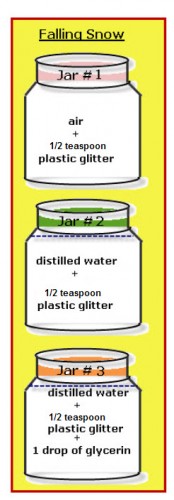Question: Why does “snow” in snow globes fall slowly?
Answer:
The “snow” can be plastic glitter or some even use finely ground egg shells. What ever is used for snow, it must be able to fall through the fluid that fills the jar (the globe).
Fluid is a term used for a gas or a liquid.
Back to the question: How fast the “snow” falls depends on the viscosity of the fluid filling the jar. The more viscous, the more fluid friction, thus the slower the snow will fall.
Let’s investigation to determine the best fluid for a snow globe.
What to Do:
1. Prepare three different jars as shown in the diagram.
2. Measure the amount of water needed to fill the jar almost full as shown by the dashed-line for jar #2 and #3.
3. Seal each jar with a lid, and then shake each jar one at a time.
4. Compare how fast the plastic glitter “snow” falls in each jar.
Author Analyzes Her Results
I found that the snow in jar #3 fell slightly slower than the snow in jar #2. The only difference between the contents of these two jars is glycerin.
Science Challenges
I wonder…Would adding more glycerin make the glitter fall even slower?
I wonder…How much glycerin would make the best snow globe? (This is an opinion. What is the best globe for you might not be what I think is best.)
Discover for Yourself
Experiment by making jars with different amounts of glycerin.

